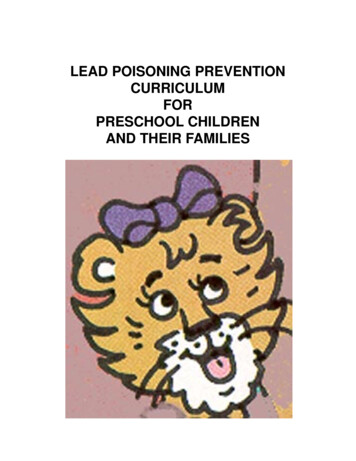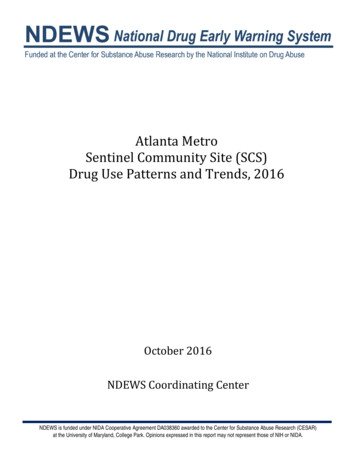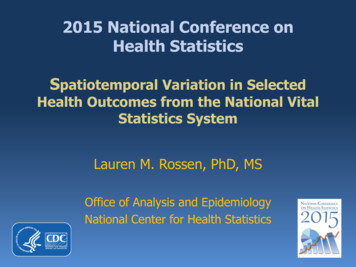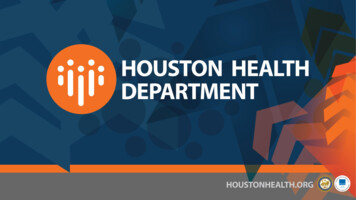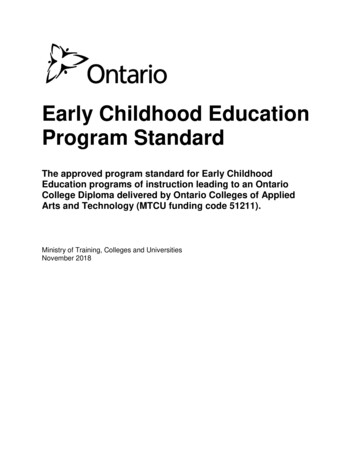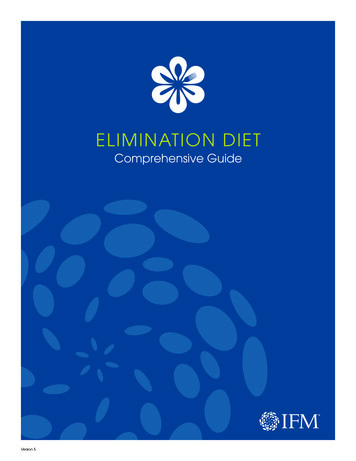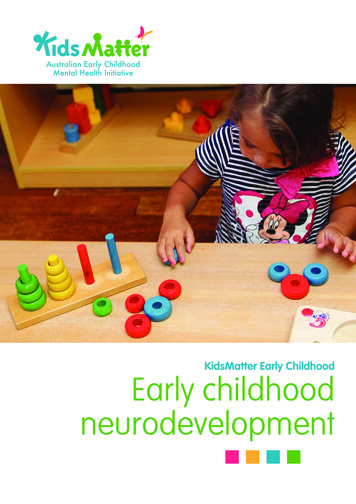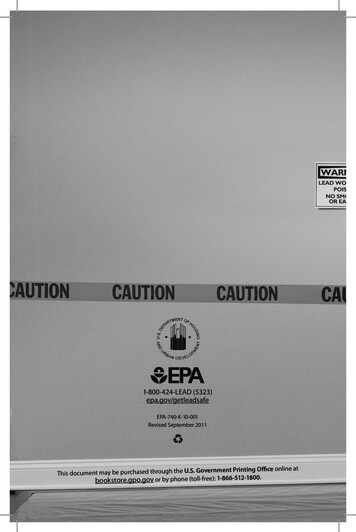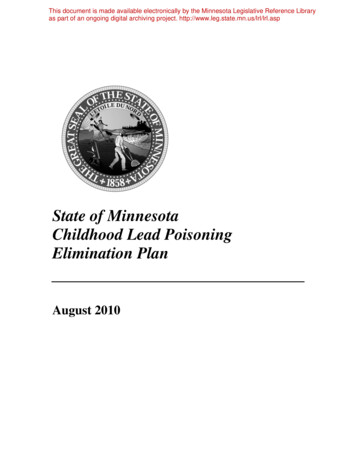
Transcription
This document is made available electronically by the Minnesota Legislative Reference Libraryas part of an ongoing digital archiving project. http://www.leg.state.mn.us/lrl/lrl.aspState of MinnesotaChildhood Lead PoisoningElimination PlanAugust 2010
This page intentionally left blank
State of MinnesotaChildhood Lead PoisoningElimination PlanAugust 2010For more information, contact:Environmental Health DivisionEnvironmental Surveillance and Assessment SectionChildhood Lead Poisoning Prevention ProgramMinnesota Department of Health625 North Robert StreetP.O. Box 64975St. Paul, MN 55164-0975Phone: (651) 201-4620Fax: (651) 201-4606As required by Minnesota Statute 3.197: This report cost approximately 5,000 to prepare,including staff time, printing and mailing expenses.If you require this document in another format, call:(651) 201-5000 or (800) 657-3908MDH TTY (651) 201-5797Printed on paper with at least 30 percent recycled content.This report has been prepared through a Cooperative Agreement with the U.S. Centers for DiseaseControl and Prevention, 5H64EG00138-04
Table of ContentsTable of Contents . iList of Acronyms . iiWork Group Participants . iiiIntroduction.1Background on Minnesota’s Lead Poisoning Problem .2Assessment of Minnesota Lead Risks.5Plan Evaluation and Modification.8MCLEAN Group Review and Comment. . 9Implementation . .11General Comments Received . . 11The Updated Goals for Elimination of Childhood Lead Poisoning .12Acknowledgements .13Implementation Goals – August 2010Goal I: Lead Education and Training.14Goal II: Identifying At-Risk Properties and Children.20Goal III: Strategies to Better Incorporate Lead Paint Assessment andControl into Housing Activities and Infrastructure. .26Goal IV: Resources to Increase the Supply of Lead-Safe Housing .29Goal V: Strategies to Develop and Implement a Program to AddressHousing-based Health Threats Based on Established LeadProgram Capacities. .33
List of AcronymsALC Unit – Asbestos/Lead Compliance Unit (MDH)CAP – Community Action Program (locally based organizations)CDBG – Community Development Block GrantCDC – U.S. Centers for Disease Control and PreventionCLEARCorps –Community Lead Education and Reduction Corps (AmeriCorps program)CLPPP – Childhood Lead Poisoning Prevention Program (CDC grant to MDH)CPSC – Consumer Products Safety CommissionC&TC – Child and Teen Check-upCUHCC - Community-University Health Care CenterDEED – Minnesota Department of Employment and Economic DevelopmentDHS – Minnesota Department of Human Services (Medicaid agency)DOLI – Minnesota Department of Labor and IndustryEBLL – Elevated Blood Lead LevelEIA Unit – Environmental Impacts Analysis Unit (MDH)EPA – U.S. Environmental Protection AgencyGIS – Geographic Information SystemHRA – Housing and Rehabilitation Authority (local housing jurisdictions)HUD – U.S. Department of Housing and Urban DevelopmentLSWP – Lead-safe work practicesLUG – Local Units of GovernmentMA – Medical Assistance (Minnesota equivalent of Medicaid)MCLEAN – Minnesota Collaborative Lead Education and Assessment NetworkMDH – Minnesota Department of HealthMDNR – Minnesota Department of Natural ResourcesMEDSS – Minnesota Electronic Disease Surveillance SystemMHFA – Minnesota Housing Finance AgencyMMHA - Minnesota Multi-Housing AssociationMPCA – Minnesota Pollution Control AgencyMVNA – Minnesota Visiting Nurses AssociationNAHRO – National Association of Housing and Redevelopment OfficialsNPCA – National Paint and Coatings AssociationOMMH – Office of Minority and Multicultural Health (MDH)RRP – EPA Renovation, Repair, and Painting rule (issued 2008)SRC - Sustainable Resources CenterWIC – Women, Infants and Children (Supplemental Nutrition Programs)Additional definitions for lead in Minnesota can be found in statute (Minn. Stat.144.9501) and in the MDH Childhood Blood Lead Case Management Guidelines forMinnesota at www.health.state.mn.us/divs/eh/lead.ii
The Childhood Lead Poisoning Elimination Plan Advisory MembersAmanda Baribeau, Minnesota Pollution Control AgencyJack Brondum, Hennepin County Community HealthJim Cegla, Minnesota Housing Finance AgencyMegan Curran, CLEARCorps USADale Darrow, U.S. Housing and Urban DevelopmentJohn Gilkeson, Minnesota Pollution Control AgencyJeff Gladis, Western Community ActionJim Graham, Hennepin County Housing, Community Works and TransitStephanie Hartmann, St. Paul/Ramsey Co Public Health Lead ProgramJack Horner, Minnesota Multi-Housing AssociationMelisa Illies, Hennepin County Housing, Community Works and TransitMike Jensen, Hennepin County Housing, Community Works and TransitJoe Jurusik, Hennepin County Community Health DepartmentMarlene Hufford, Isanti County Public HealthCris Nelson, Minnesota Visiting Nurse AgencyDan Newman, Sustainable Resources CenterNathan Olson, City of Minneapolis Healthy Homes & Lead Hazard ControlBill O’Meara, Community Action Partnership of Suburban HennepinSarah Rudolf, Coalition to End Childhood Lead PoisoningEliza Schell, City of Minneapolis Healthy Homes and Lead Hazard ControlBruce Scott, Bloomington Public HealthLisa Smestad, City of Minneapolis Healthy Homes and Lead Hazard ControlSue Spector, C&TC Coordinator Dakota County Public HealthJennifer Tschida, City of Minneapolis Healthy Homes & Lead Hazard ControlCarol Wentworth, Carver County Public HealthLaura Wright, U.S. Housing and Urban DevelopmentJim Yannarelly, St Paul-Ramsey County Public HealthMDH staff participating in Plan meetings were:Randi Callahan, CLPPP State Case MonitorLarry Gust, Environmental Surveillance and Assessment Section ManagerDale Dorschner, Indoor Environments and Radiation Section ManagerNancyjo LaPlante, Asbestos and Lead Compliance UnitDan Locher, Asbestos and Lead Compliance Unit SupervisorLarry Olson, CLPPP Surveillance Quality ControlTodd Schaefer, Asbestos and Lead Compliance UnitDaniel Symonik, Supervisor, Environmental Impact Analysis UnitDan Taylor, HUD Lead Hazard Control CoordinatorJulia Wooldridge, CLPPP Database ManagerErik Zabel, CLPPP Principal Investigatoriii
IntroductionAlthough lead poisoning is preventable and rates are declining in Minnesota, childrenliving in substandard (as defined by building codes), pre-1950 housing continue to bedisproportionately affected by lead. In response, the Minnesota Department of Health(MDH) Childhood Lead Poisoning Prevention Program (CLPPP), in collaboration with awide range of partners, has coordinated the development of a plan to eliminate statewidechildhood lead poisoning by 2010. The “State of Minnesota Childhood Lead PoisoningElimination Plan” (Plan) contributes to meeting the national goal established by the U.S.Centers of Disease Control and Prevention (CDC) of eliminating childhood leadpoisoning as a public health problem by 2010.The original Plan was released in 2004. Members of the Minnesota Collaborative LeadEducation and Assessment Network (MCLEAN) meet routinely to evaluate ongoingefforts in the Plan. The MCLEAN meetings also provide an opportunity for sharinginformation, form collaborations, and learn about current lead issues. Attendees atMCLEAN meetings include federal, state, and local government; community basedorganizations; health care providers; housing, real estate, landlord, and tenantorganizations; and other disciplines. All members listed on p. iii as “Childhood LeadPoisoning Elimination Plan Advisory Members” (Advisory Members) participate inMCLEAN meetings. In addition, key staff from the MDH Lead Program, which includesthe Environmental Impact Analysis Unit (EIA) and the Asbestos/Lead Compliance Unit(ALCU), provided feedback on the Plan. Particular attention has been paid to developingand implementing housing-based primary prevention activities.In 2004 a vision statement for the Plan was prepared along with a Minnesota definition ofchildhood lead poisoning “elimination.” The vision statement and elimination definitionremain valid in 2010. The vision statement is:“To create a lead-safe Minnesota where all children have blood lead levels below 10micrograms lead per deciliter whole blood (µg/dL) by the year 2010.”The elimination definition is:“Lead poisoning will be considered eliminated when zero percent of at-risk children whoare less than 72 months of age have blood lead levels 10 µg/dL.”**** The definition of elimination is subject to change due to at least three variables: 1) changes in trends inelevated blood lead levels (EBLLs) determined by ongoing analyses of blood lead surveillance and relateddata; 2) ongoing childhood lead poisoning prevention activities by governmental and nongovernmentalagencies; and 3) changes to federal or state guidelines regarding acceptable levels of childhood blood lead.As we enter 2010, there has been tremendous progress in lowering exposure to lead, bothnationally and in Minnesota (a 65% reduction in EBLLs since 1995). While the CDC hasissued the “Healthy People 2020” objective (EH HP2020-13) to “eliminate elevatedblood lead levels in children” there is ongoing discussion in the lead communityregarding what constitutes “elimination” at the national level. Commentators on the1
proposed Healthy People 2020 objective noted that the definition of elimination shouldbe qualified by adding “as a public health problem”, which recognizes the impracticalityof attaining zero lead exposure. CDC has also discussed (in informal meetings) using theNational Health and Nutrition Examination Survey (NHANES) data to establish anational statistical threshold that would constitute no observed cases, or “elimination.”During the creation of the Plan in 2004 there was extensive discussion regarding theMinnesota definition of elimination. The consensus of the group in 2004 was that weshould strive for “zero percent of at-risk children” as a goal while recognizing that lead isa common contaminant in the environment. Discussions held with the Advisory Membersin 2010 confirmed that the Plan should retain the established definition of elimination.This Plan contains background on lead exposure in Minnesota, an assessment of riskfactors for lead, and an overview of modifications to the Plan proposed by AdvisoryMembers. The 2010 version of the Plan updates the most recent version of the Plan,which was released in September 2008. An evaluation of the 2010 Plan will be preparedand distributed in 2011.Background on Minnesota’s Lead Poisoning ProblemThe State of Minnesota has consistently played a leading role in identifying andaddressing public health issues related to lead exposure. Partners in lead poisoningprevention across Minnesota are committed to maintaining that leadership role andprotecting the citizens of Minnesota from the potentially devastating effects of exposureto high levels of lead.The MDH is the lead state agency for childhood lead poisoning prevention effortsstatewide. Lead poisoning prevention activities at MDH are housed within the Divisionof Environmental Health. The EIA Unit is responsible for lead-related surveillanceactivities, assists in monitoring elevated blood lead cases, coordinates education andoutreach, and implements the CLPPP. The ALC Unit is responsible for assuringcompliance with state rules and statutes dealing with lead hazards. Other state agenciesdealing with lead include the Pollution Control Agency, Agriculture, Labor and Industry,Natural Resources, Housing Finance Agency (MHFA), Commerce, and Employment andEconomic Development (DEED). At the local level, cities of the first class andcounties/local public health agencies have a wide variety of duties with respect to leadrisk assessment and case management. Nongovernmental advocacy organizations, suchas the Sustainable Resources Center and CLEARCorps Minnesota, also perform essentialtasks regarding education, training, and primary prevention pilot projects andassessments.The MDH collects blood lead reports on all tested Minnesota residents, both children andadults. State guidelines on screening of children and pregnant women, case management,and clinical treatment help standardize practices and raise awareness of high-riskpopulations. These guidelines are regularly reviewed and updated based on new data andpublished literature.2
Figure 1 illustrates the trend in the number of children tested in past years and gives someindication of how screening practices have improved significantly in Minnesota. Onlydata for children less than six years old are presented.Figure 1: Number of children with blood lead tests reported to MDH from 1995 – 2009. Resultsinclude all test types (venous, capillary, and unknown).Number of Children 006200720082009The dramatic increase in blood lead screening in Minnesota is the result of the combinedefforts of local, state and federal government and private organizations recognizing theimportance of testing children at high risk for lead poisoning and implementinginnovative strategies to provide those services to an increasingly diverse and mobilepopulation.At the state level, the MDH Blood Lead Screening Guidelines for Minnesota were issuedin 2000 and have been updated, distributed and promoted among health care providersstatewide. In addition, the MDH produces annual reports on blood lead testing,presenting information by county to provide local partners with data about theirjurisdictions. The MDH also enforces lead regulations, trains and certifies leadprofessionals, and collaborates with DEED on U.S. Department of Housing and UrbanDevelopment (HUD) lead hazard control grants. The Minnesota Department of HumanServices (DHS) established targets and financial incentives for health plans to performcomplete Child and Teen Checkups (C&TC), of which blood lead testing is a vitalcomponent, on children enrolled in Minnesota Health Care Plans, including MedicalAssistance (MA).Other screening efforts have included targeted projects in Minneapolis, St. Paul-RamseyCounty, Hennepin County, rural counties in west-central Minnesota, WIC clinics in highrisk counties, and specific screening projects for refugees and immigrants. As shown inFigure 2, the number of confirmed elevated blood lead levels reported to MDH has beengradually declining over time, consistent with national trends.3
Figure 2: Number of children less than 72 months old with elevated blood lead tests reported toMDH from 1995 – 199719981999 20002001 2002 2003 2004 2005 2006 2007 2008 2009Blood Lead Level 10 ug/dL (capillary and venous)Blood Lead Level 15 ug/dL (venous only)Table 1 presents the distribution of blood lead tests reported to MDH in 2009 based onconcentration. The data show that 778 of the 94,972 children with reported tests (0.8percent) were considered to be elevated, which is defined by Minnesota statute as greaterthan or equal to 10 µg/dL. The rate of venous blood lead tests requiring an environmentalassessment (15 µg/dL or greater) for Minnesota for 2009 was 0.3 percent.Table 1: Distribution of Blood Lead Levels in Minnesota Children in 2009. Data are number ofchildren in a given range. If a child had multiple tests, the highest venous level was chosen, followedby the highest capillary level if no venous test was performed.Blood Lead Level (µg/dL) 55-910-1415 972Compliance monitoring ensures that lead hazard reduction is completed consistent withstate statutes and best public health practices. This involves working with assessingagencies and licensed lead workers to address exposure issues (e.g. lead paint removal,window replacement). Training is provided, inspections performed, and assessmentsaudited as needed to ensure that public health concerns are addressed. Health education isperformed within the lead programs using well-established information sources (such as aroutinely updated Web site) and targeted outreach opportunities. Specific methods forimplementing the recently passed “Renovation, Repair, and Painting” rule from EPA arecurrently being developed.The complete list of assessing agencies in Minnesota is presented in Table 2 below.These are the governmental agencies with authority to conduct enforceable lead riskassessments on elevated blood lead cases. Many of these groups, along with nonprofit,private, and other organizations, also conduct advisory risk assessments across the statefor concerned households on a voluntary basis, regardless of blood lead level.4
Table 2: Assessing Agencies in Minnesota.MDH (82 Counties)City of BloomingtonDakota CountyCity of MinneapolisSt. Paul-Ramsey CountySt. Louis CountyCity of RichfieldHennepin CountyStearns CountyLead programs across Minnesota strive to devise unique and innovative approaches toinstitutional and scientific problems. These include forming cooperative workgroups tosolicit input prior to generating guidelines, cooperating with other agencies to meetcommon goals, conducting research to address information gaps, and overseeing leadhazard reduction efforts to ensure complete and timely resolution of lead orders. Diversepopulations are targeted to help address public health disparities. Programs across theState are flexible, responsive, and well grounded in the core public health functions ofassessment, assurance, and policy/planning.Assessment of Minnesota Lead RisksThe MDH maintains an extensive blood lead surveillance system for the purpose ofmonitoring trends in blood lead levels in adults and children in Minnesota. There are1,000,000 tests in the system as of April 11, 2008. Of these tests, 864,313 were for kidsunder the age of six, and they were from 583,591 individual children. Data collectiongoes back to 1995 and is used to help identify populations at risk for elevated blood leadlevels, ensure that screening services are provided to groups with the highest risk of leadpoisoning, and provide environmental and medical follow-up to children with elevatedblood lead levels.Work in Minnesota (e.g., Countryside Lead Prevalence Study) and nationally has shownthat an estimate of lead risk may be predicted based on two factors: living in a pre-1950home and being enrolled in Medicaid. The data shown in Table 3 below are taken fromthe 2000 Census and DHS Medicaid enrollment figures for 2001. These figures do nottake into account homes that have already been made lead-safe and assume that theproportion of children is constant across different ages of homes. Children were definedas individuals less than 72 months of age. The number of children is based on a five-yearperiod, assuming approximately 67,000 children per year group.Table 3: Housing and population characteristics for Minnesota lead risk factors, based on 2000Census data.Built 1950Built 1960All Homes560,322 (27%)810,152 (39%)2,065,946# Children in Minnesota 72 mo. (5 yr. period)180,000330,000660,000# Enrolled in Medicare(5 yr. period)44,00063,000160,000# Housing Units in year 20005
The following responses to an elevated blood lead report are outlined in MinnesotaStatute (MS 144.9504) and the MDH Childhood Blood Lead Case ManagementGuidelines for Minnesota (updated in 2006): If levels are less than 10 µg/dL information is entered into thesurveillance database and education materials identifying primarysources of lead poisoning may be provided to the family.If levels in children are 10 µg/dL or greater, follow-up or confirmationtesting and educational intervention are called for. This includes givingthe children’s parents or guardian a letter, bringing in the child forfollow-up or confirmation testing, and providing information on howto reduce and/or avoid exposure to lead in the environment.If venous lead levels in a pregnant woman are 10 µg/dL or greateror are 15 µg/dL or greater for children, environmental follow-up isrequired. This includes a housing risk assessment and may also includean education visit from a public health nurse, enforcement orders, leadhazard reduction or remediation, and clearance testing.Levels of 60 µg/dL or greater indicate a medical emergency, andimmediate action is taken.Although Minnesota has mandatory reporting from all facilities analyzing blood leadlevels, blood lead testing is not universal, and the data collected by the surveillancesystem are not representative of all Minnesota children. Data are collected only when ahealth care provider orders a blood lead test or a child is screened in the community byrequest of the parent or guardian. The percentage of children tested varies greatly fromcounty to county and from year to year.Based on 2009 data, 19 percent of the children in the Minnesota blood lead surveillancedatabase reside in Minneapolis and St. Paul even though these cities contain only 15percent of the state population of children. Therefore, the database contains fairly reliableinformation on the prevalence of lead poisoning in urban areas of Minnesota. Evidenceshows, however, that some populations statewide are clearly at risk. For example, it isestimated that 57 percent of the Medicaid-eligible population in Minnesota did notreceive a blood lead test in 2009. Although ongoing data matching shows that this trendis improving (83 percent did not receive a blood lead test in 1999), it remains well shortof the goal of 100 percent screening in Medicaid populations. In addition, a studyconducted in a representative rural area of Minnesota showed lead poisoning rates of 2.1percent at or above 10 µg/dL and 0.7 percent at or above 20 µg/dL, which is slightlybelow the rate reported to the MDH surveillance system but relatively consistent withnational prevalence estimates.6
Statewide Lead Poisoning Risk EstimatesFigure 3:Surveillance data from MDH has shown that the mostimportant factors related to lead poisoning risk inMinnesota are the percentage of children in poverty andthe percentage of homes built before 1950. Both ofthese characteristics were used, in conjunction with thepopulation of children under six, to estimate thepopulation-adjusted lead poisoning risk for individualgeographic areas. For each geographic area the “CountyRisk” equals the number of children less than six yearsof age multiplied by the fraction of children in povertymultiplied by the fraction of homes that were built priorto 1950. The resulting number is not the expectednumber of EBLLs or percentage of EBLLs. It is simplya population-adjusted factor for comparing lead riskbetween counties or zip codes. Using the statewidecounty-level risk estimation, three counties have thegreatest potential for lead poisoning (Figure 3). Ofthese, two counties contain the largest cities inMinnesota, Minneapolis (Hennepin) and St. Paul(Ramsey). Current state screening guidelinesrecommend screening of all children in Minneapolis and St. Paul at one and two yearsold. The other county at highest risk is St. Louis County, which contains the secondlargest urban area in Minnesota, the city of Duluth. Five counties are in the moderatecategory of lead poisoning risk (Beltrami, Otter Tail, Stearns, Blue Earth, and Winona).The remaining counties in Minnesota are at lower risk for significant numbers of leadpoisoned children.Figure 4:Even within urban counties, most elevated blood leadtests are identified in Minneapolis and St. Paul. In 2007,88 percent of the children with blood lead levels 10µg/dL, and 95 percent of the children with blood leadlevels 15 µg/dL in Ramsey county lived in St. Paul,and 84 percent of the children with blood lead levels 10 µg/dL and 84 percent of the children with blood leadlevels 15 µg/dL in Hennepin county lived inMinneapolis.In addition to statewide relative lead risk, city-specificdata were examined to more specifically determine themost at-risk areas for lead poisoning. Lead poisoningrisk data by zip code for St. Paul and Minneapolis arepresented in Figure 4. Both Minneapolis and St. Paulare classified as “cities of the first class” and aretherefore designated as assessing agencies by7
Minnesota Statute and are responsible for lead risk assessment and case management.Local data show that elevated test results in Minneapolis tend to concentrate in the NearNorth and Phillips Communities. Near North is one of the poorest in the City, has thegreatest number of subsidized housing units, and is home to the highest ratio ofMinneapolis’ children under age six. Most families are below the 80 percent povertylevel, and are eligible for Medicaid programs. Nearly 90 percent of the housing stock inthe Near North Community was built prior to 1950, 52 percent are rental units, and 34percent of housing is classified as "Below Average.”The City of St. Paul is divided into more than 80 individual census tracts. During the pastfive years, one or more children residing in 56 of these census tracts have been identifiedas having an elevated blood lead level. Of these 56 census tracts, a single census tract inthe Thomas-Dale neighborhood has nearly twice as many elevated blood lead cases as theother 55 combined. The age and condition of housing within this target area is veryconsistent. Nearly 90 percent of the homes were built prior to 1940. Local data indicatesthat 95 percent of these homes contain lead based paint and 84 percent have deterioratedlead-based paint. This census tract is very near a major interstate. It has high levels oflead in the soil and many deteriorated houses throughout its neighborhoods.In addition to housing-based lead, there has been a great deal of attention paid to othersources of lead in recent years. In Minnesota, this has included tracking recalls ofproducts with lead, passing legislation in 2007 banning lead in children’s jewelry ll.php?bill S1262.3.html&session ls85 ),working on addressing lead in upland game shot and hunter-donated venison, providingnational leadership on using lead-free wheel weights and fishing tackle, and raisingawareness of lead in traditional/imported products in immigrant populations.Plan Evaluation and ModificationsThe measures presented in the “Implementation Goals” table (pp. 14-35) are used asbenchmarks for conducting ongoing evaluation of the Plan and developing newobjectives and tasks. The MDH currently convenes the MCLEAN twice a year (generallyin April and October) to review Plan progress and discuss any needed modifications toreach stated goals and objectives. An overview of progress on the Plan is a standardagenda item at all MCLEAN meetings, as is information about successful strategies andbarriers to progress. Additional meetings with Advisory Members are called as needed toreview and update specific Goals.A bi-annual evaluation of the Plan (most recently completed in 2009) assessing progresstowards goals and objectives is prepared and posted on the MDH Lead Program Web siteat www.health.state.mn.us/divs/eh/lead.Lead poisoning prevention efforts are ongoing throughout the year and are conducted bya wide range of collaborating partners, including federal agencies, public health agencies(both state and local), housing agencies, health plans, health care providers, advocacy8
organizations, legislators, and concerned citizens. Highlighted activitiescompleted/continued since the 2009 evaluation of the Plan include: Minneapolis and SRC provide the EPA “Renovate Right” pamphlet to hardwarestores, reuse centers, lumber yards, and community centers. Surveillance data was used to target clinic outreach efforts in Minneapolis toencourage screening (MDH Screening Guidelines recommend universal screeningfor Minneapolis) and awareness of case management practices. Coordination meetings included the Lead Testing Task Force, theMinneapolis/Hennepin County Lead Workgroup and regular meetings betweenMDH and SRC. St. Paul/Ramsey County public health completed training for contractors todevelop capacity for lead safe work practices. SRC and CLEARCorps conducted a wide array of community education andoutreach activities targeted to diverse communities. These events frequentlyoffered lead testing, which was coordinated with health plans. Minneapolis provided LSWP training to facilitate compliance with a cityordinance addressing chipping and peeling paint. MDH worked with the legislature and many partners in the lead compliancecommunity to begin implementation of the EPA RRP rule. Minneapolis and SRC instituted a “Lunch and Learn” series (CEUs available)targeting clinics, nurses, physicians, and health plan administrators.MCLEAN Group Review and CommentIn 2010, the Advisory Members also met to discuss possible revisions to theImplementation Goals. A series of meetings in the summer of 2010 gathered all theAdvisory Members to review and amend each of the goals. Meetings on April 6 (whichwas the regularly scheduled MCLEA
State of Minnesota . Childhood Lead Poisoning Elimination Plan . August 2010 . For more information, contact: Environmental Health Division . Environmental Surveillance and Assessment Section . Childhood Lead Poisoning Prevention Program . Minnesota Department of Health . 625 North Robert Street .
